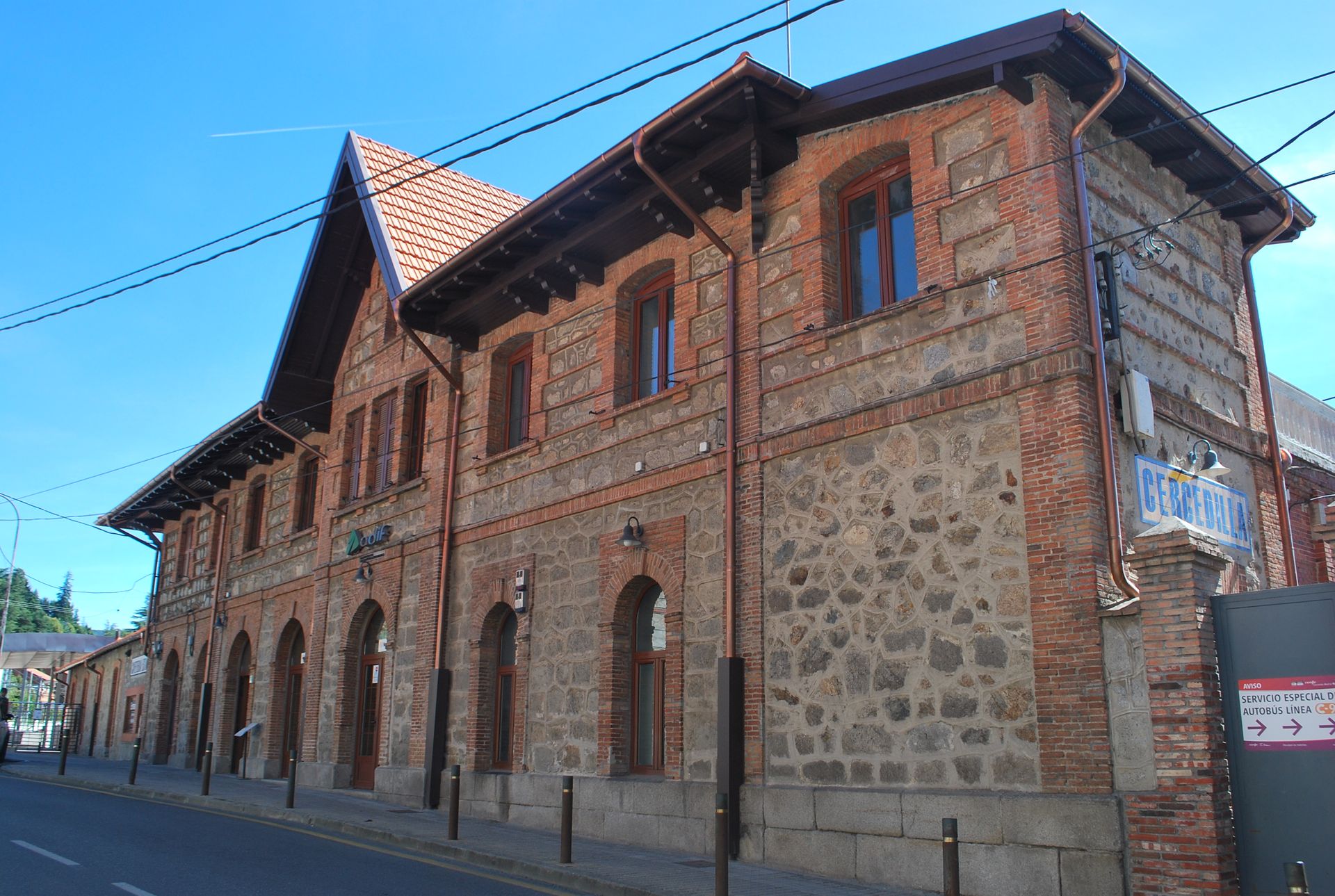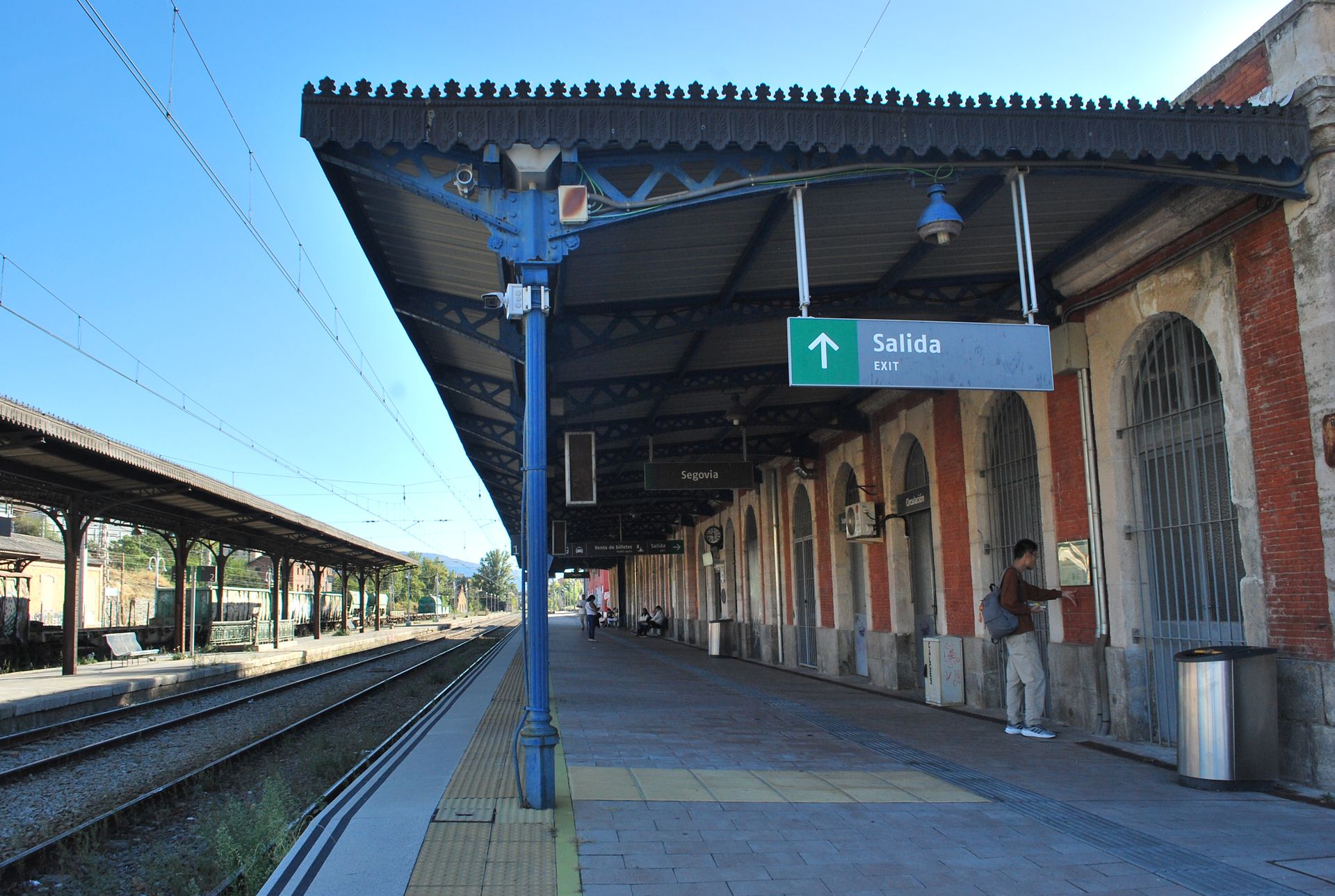Cercedilla – Segovia
CHARACTERISTICS
- Segovia (UTM 30T 406245 4532039) / VIAJEROS
- La Losa-Navas de Riofrío (UTM 30T 403815 4523465) / VIAJEROS
- Ortigosa del Monte (UTM 30T 401511 4520853) / VIAJEROS
- OUT OF SERVICEOtero-Herreros (UTM 30T 398478 4517352) / VIAJEROS
- Los Ángeles de San Rafael (UTM 30T 398118 4514870) / VIAJEROS
- El Espinar (UTM 30T 399571 4510664) / VIAJEROS
- San Rafael (UTM 30T 400216 4507791) / VIAJEROS
- Gudillos (UTM 30T 402220 4507975) / VIAJEROS
- Tablada (UTM 30T 404934 4506686) / VIAJEROS
- Cercedilla (UTM 30T 409962 4510165) / VIAJEROS
In May 1883, the Spanish Parliament approved the construction of the railway line between Villalba and Segovia, after several decades of social and political demands from the Castilian-Leonese capital to obtain a rail connection with Madrid. A little over a year later, in July 1884, the contract for the work was awarded, and after a construction period of five years, it was inaugurated in June 1888. [1] [2]
The approved route required the construction of seven tunnels to cross the Sierra de Guadarrama and connect the northern plateau with the southern plateau. [3]
Originally, this line and the Segovia-Medina del Campo line formed an alternative to the Madrid-Hendaye line, to which they connected at both ends. This allowed long-distance trains to stop in Segovia or to take a detour in the event of blockages on the main line. Low demand along much of the route led to the closure of the section between Medina del Campo and Segovia in 1993. In addition, after the opening of the Ferrocarril de Cotos, it was decided to connect the line to the conventional railway network at Cercedilla station. [4]
Originally, this line and the Segovia-Medina del Campo line formed an alternative to the Madrid-Hendaye [...]
The first electrification of the section, with 1.5 KV direct current, was completed in two phases, the first in 1944 between Villalba and Cercedilla, and the second as far as Segovia in 1946. Subsequently, in 1972, the entire route was changed to 3 KV DC. [5] [6] [7]
Currently, the section between Villalba and Cercedilla belongs to the C-8 Madrid commuter line, while line 53 services are operated with Renfe’s Regional Medium Distance trains. [8]
Currently, the section between Villalba and Cercedilla forms part of line C-8 of the Cercanías Madrid commuter rail network.

Apartadero de Cecedilla (Madrid)
Recently, in 2021, the Segovian Business Federation (FES) announced the Prado del Hoyo business project, a logistics platform that will use a newly constructed branch line to distribute goods along this railway line. [9]
This line also offers some unique tourist services, due to the beauty of the landscapes it crosses and the history of the cities it connects. Thus, the Association of Friends of the Madrid Railway holds various activities. And the Plaza Mayor Cultural Association of Segovia promotes every year ‘the train of emotions’, a cultural event on board in which the trades of railway employees are recreated. [10] [11]
Several Segovian town councils are continually calling for the revitalisation of the line by increasing the frequency of services and promoting its use. [12] [13]
Several Segovian town councils are continually calling for the revitalisation of the line [...]
In landscape and cultural terms, it is a line of historical origin that crosses a mountain landscape of great scenic quality and deep historical significance. It is an area well known to people from Madrid and Segovia, who seek to escape the bustle of the cities in these valleys and mountains. It is an established local tourist destination with deep historical, literary, cultural and natural significance.
Category A1
Electrified track with concrete sleepers in a good state of repair.
Photographic report

Vista de la Línea 110

Apeadero de San Rafael (Segovia)

Apeadero de Ortigosa del Monte (Segovia)

Paso a nivel sobre la Línea 110

Estación de Segovia
References
-
Asociación de Amigos del Ferrocarril de Collado Villalba, «Línea Villalba-Segovia», Asociación de Amigos del Ferrocarril de Collado Villalba.
-
«Diario oficial de avisos de Madrid», Hemeroteca Digital. Biblioteca Nacional de España, 07-jun-1884.
-
L. de León Megnie, Guadarrama. Biblioteca de la provincia de Madrid: crónica de sus pueblos. Editorial MAXTOR, 2011.
-
I. G. Mardones, «La nieve intercepta las comunicaciones con el norte de España por carretera y ferrocarril», Ediciones EL PAÍS S.L, 01-mar-1993.
-
ABC, «El Caudillo inaugura el ferrocarril eléctrico Madrid-Segovia», ABC, 10-feb-1946.
-
La Vanguardia, «Inauguración del servicio eléctrico Madrid-Segovia», La Vanguardia Hemeroteca, 01-1946.
-
Vía Libre, «Termina la electrificación a 1500 V», Vía Libre.
-
T. F. Morini, «Último tren del día a Segovia», Ediciones EL PAÍS S.L, 17-may-2013.
-
D. Aso, «FES apuesta por un proyecto de puerto seco para Segovia», El Día de Segovia, 17-may-2021.
-
Asociación de Amigos del Ferrocarril de Madrid (AAFM), «Río Eresma Tren Turístico», Trenrioeresma.es
-
El Norte de Castilla, «El Tren de las Emociones reivindica la continuidad de la línea convencional Segovia-Madrid», El Norte de Castilla, 13-feb-2011.
-
El Norte de Castilla, «El Ayuntamiento de El Espinar pedirá a Renfe la revitalización de la línea a Madrid», El Norte de Castilla, 23-dic-2016.
-
C. Álvaro, «La Diputación respalda sin fisuras la mejora de la vieja línea del ferrocarril entre Cercedilla y Segovia», El Norte de Castilla, 27-ene-2017.